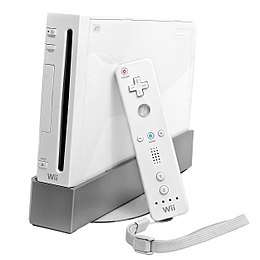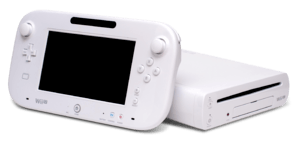GameCube controller
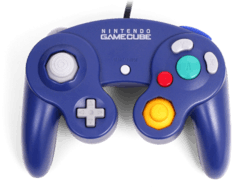 Indigo GameCube controller | |
| Manufacturer | Nintendo |
|---|---|
| Type | Gamepad |
| Generation | Sixth generation |
| Release date |
|
| Input |
|
| Connectivity | GameCube controller port |
| Dimensions |
2.5 × 5.5 × 4 in; 6.5 ft cable 65 × 140 × 100 mm; 2 m cable |
| Predecessor | Nintendo 64 controller |
| Successor |
Wii Remote Classic Controller |
The GameCube controller is the standard controller for Nintendo's GameCube video game console.
Overview

Released alongside the GameCube console, the standard GameCube controller has a wing grip design. This controller was bundled with all new GameCube systems throughout the console's life cycle and was also available separately. It connects to the console's controller ports via a 2 m/6.5 ft cable.
The standard GameCube controller provides haptic feedback by way of a built-in rumble motor rather than using an external Rumble Pak add-on like the Nintendo 64 controller. Also unlike its predecessor, this controller does not feature any expansion capabilities.
The controller features a total of six digital buttons, two analog sticks, a d-pad and two hybrid analog triggers/digital buttons.
The primary analog stick is on the left, with the D-pad below it. The four face buttons are on the right of the controller (a large green "A" button in the center, a smaller red "B" button to its bottom left and two kidney-shaped buttons; "X" to the right and a "Y" to the top) with a yellow "C" stick below those. A Start/Pause button is located in the middle of the controller. On the "shoulders" of the controller there are two analog triggers marked "L" and "R," as well as one digital button marked "Z" which sits above the "R" trigger. The "L" and "R" triggers feature both analog and digital capabilities. Each of these behaves as a typical analog trigger until fully depressed, at which point the button "clicks" to register an additional digital signal. This method effectively serves to provide two functions per button without actually adding two separate physical buttons.
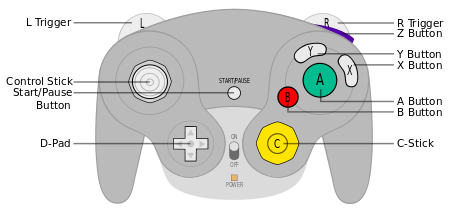
Versions

Colors/designs
Standard editions
The GameCube controller was sold in several different colors over the console's lifespan. Standard colors included "Indigo" (Purple), "Jet Black", "Platinum" (Silver) and "Spice" (Orange);[2] these were bundled with their respective colored GameCube consoles and sold separately in many countries.[1] Other standard colors sold separately included "Indigo/Clear" (Indigo top with a clear translucent bottom), "Emerald Blue" (Turquoise), and White; the latter two were only available in Japan.[1]
Limited editions
Nintendo released a number of limited edition controllers in Japan through Club Nintendo, which featured a unique color scheme and/or logo in the center. Club Nintendo controllers could be purchased for 500 points each and designs included "Mario" (red top and blue bottom),[3] "Luigi" (green top and blue bottom),[4] "Wario" (yellow top and purple bottom)[5] and a "Club Nintendo" controller (white top and light blue bottom).[6] The "Mario" design was also made available in limited quantities through the European Stars Catalogue for 5000 points.[7]
Additionally, a number of limited edition GameCube consoles have been released which included matching controllers. Colors released in Japan include "Starlight Gold",[2][8] "Crystal White",[9] "Symphonic Green" (mint green),[10] "Hanshin Tigers" (black with Hanshin Tigers logo),[11][12] "Gundam Copper" (two-tone red with Gundam logo)[2][10] and "Transparent" which was included with the "Enjoy Plus Pack +" bundle.[13] The "Symphonic Green" and "Crystal White" colors were also released in Europe, although the latter was renamed "Pearl White" and bundled with Mario Smash Football.[14] A Resident Evil 4 controller (Silver top and black bottom with logo) was available in Europe as part of a limited edition Resident Evil 4 console bundle.[10][15] The Panasonic Q, a GameCube/DVD player hybrid system exclusive to Japan, came bundled with a grey Panasonic branded version of the controller.[2][16]
WaveBird wireless controller
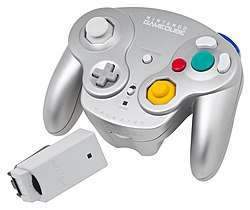
The WaveBird wireless controller is an RF-based wireless controller based on the same design as the standard controller. It communicates with the GameCube system wirelessly through a receiver dongle connected to one of the system's controller ports. It is powered by two AA batteries. As a power-conservation measure, the WaveBird lacks the rumble function of the standard controller.
LodgeNet controller
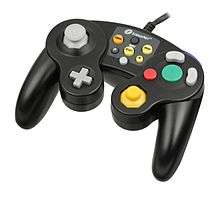
A specially-designed variation of the GameCube controller was created for the LodgeNet in some North American hotels. The controller can be used for pay-per-play access to select GameCube titles. In addition to the standard GameCube controller inputs, the LodgeNet controller features six additional buttons which are used to control the on-screen game selection interface. The controller can not be used on regular home systems.
Availability
Official controllers are becoming scarce at retailers, as a result of increased demand of the controller due to the Wii's backward compatibility with GameCube games and the fact that several Wii games support the controller as a primary method of control. In response to the regained popularity, Nintendo decided to re-launch the Gamecube controller.
White controller
In April 2008, Nintendo released a white GameCube controller, exclusive to Japan.[17] The controller has not been released outside Japan, but online retailers such as Amazon.com and Play-Asia do import and sell the controller internationally.[18][19] It differs from previous editions in that it features a white cable which is 3 m (9.8 ft) long, rather than the 2 m (6.5 ft) black cable used on standard controllers. In 2014, the manufacturing production of the white controller was resumed under the Super Smash Bros. branding, again exclusively for Japan (see more info on the Super Smash Bros. edition below).
Continued production of platinum controller
Nintendo of America continued to sell wired platinum controllers up until early 2012 in North America, but have since sold out. It is unknown if they will ever go through another production run.[20]
Super Smash Bros. Edition controller
The Super Smash Bros. edition controller was released in 2014, in conjunction with the release of Super Smash Bros. for Wii U. The controller features a metallic silver Super Smash Bros. logo surrounded by flames instead of the Nintendo GameCube logo. It comes in standard black worldwide, although a white version was released in Japan only.[21] These controllers have much longer cables than the original controllers.[22] Along with the release of the controller, Nintendo released a GameCube controller adapter for the Wii U. The adapter supports four GameCube controllers, and all original pads are supported. A second adapter can be hooked up to a console, allowing up to eight players to use a GameCube controller. The adapter is only officially compatible with Super Smash Bros. for Wii U; no other games allow its use, although some homebrew software is compatible with the adapter and allows it to be used on other games.
During the Electronic Entertainment Expo 2018, Nintendo confirmed it is re-issuing the black GameCube controller for use with Super Smash Bros. Ultimate for the Nintendo Switch as the game officially supports the controller (in docked mode only, though it is still possible to play in tabletop mode via adapter) like its Wii and Wii U predecessors. The re-issued controller will be released on November 2nd 2018, and will feature a simplified variant Super Smash Bros. emblem design. On the same day, Nintendo will also re-issue the official USB GameCube controller adapter, with a generic Nintendo embossed branding unlike the first edition that featured the Wii U logo.[23] The Nintendo Switch itself and some of its games is technically capable of supporting the GameCube controller in docked mode (it can also be played in tabletop mode via HORI’s Multiport USB Playstand) after a system update issued in October 2017.[24]
Use on subsequent consoles

Due to the Wii's ability to use GameCube controller input, all official GameCube controllers may be used on the Wii. GameCube software played on the Wii requires the use of a GameCube controller (and, for games with save data, a memory card), and cannot be played with standard Wii controllers. Wii software can be programmed to make full use of GameCube controllers. Nearly all Virtual Console games and certain Wii and WiiWare games have been designed to support GameCube controllers as input. However, some later Wii models, such as the Wii Family Edition and Wii Mini, lack support for GameCube software, controllers, and memory cards.
Although the follow-up console, the Wii U, also omits compatibility with GameCube software and hardware, Nintendo announced that an official adapter would be released that allows players to connect up to four GameCube controllers to the Wii U via its USB ports.[25] Though its initial product listing stated it would be compatible with any Wii U title that supports the Wii U Pro Controller,[26] Nintendo since corrected the listing, stating the adapter can only be used with Super Smash Bros. for Wii U and would not be compatible with other Wii U or Wii software.[27] The adapter launched alongside the game in November 2014, both separately and as part of a bundle with the game.[28][29] Support for the adapter on Nintendo Switch was introduced via its 4.0 firmware update; unlike the Wii U, it is supported by any game, although functionality may be affected if a game's bindings utilize buttons not found on the GameCube controller.[30]
Replications

Accessory maker PDP began releasing a line of officially licensed "Wired Fight Pad" controllers for the Wii and Wii U in 2014, with color schemes based on various Nintendo characters. They are based on the design and layout of the GameCube controller, but are connected via the Wii Remote's expansion port and act identically to a Classic Controller Pro (thus supporting any Wii and Wii U game that supports the Classic Controller Pro, but not GameCube games). To provide parity with the Classic Controller Pro, these controllers feature dual shoulder buttons, as well as the "+", "−", and "Home" buttons that the GameCube controller lacks. The smaller C-stick is also replaced with the larger[31][32][33] Hori released a similar product line known as the "Battle Pad".[34]
In anticipation of Super Smash Bros. Ultimate, both Hori and PDP unveiled similar replications as USB gamepads for Nintendo Switch. As with their Wii U counterparts, they maintain similar designs to the standard GameCube controllers, but updated to include dual shoulder buttons and Switch system keys.[35][36]
Legal issues
Anascape Ltd, a Texas-based firm, filed a lawsuit against Nintendo for patent infringements regarding Nintendo's controllers.[37] A July 2008 verdict found that a ban would be issued preventing Nintendo from selling the regular GameCube and WaveBird controllers in the United States. Nintendo was free to continue selling the controllers pending an appeal to the U.S. Court of Appeals for the Federal Circuit.[38] On April 13, 2010, Nintendo won the appeal and the previous court decision was reversed.[39]
See also
References
- 1 2 3 ニンテンドー ゲームキューブ/カラーバリエーション [Nintendo GameCube / Colors] (in Japanese). Nintendo. Retrieved September 9, 2010.
- 1 2 3 4 "Samurai Nintendo : GameCube models & special editions". samurainintendo.com. Retrieved September 9, 2010.
- ↑ IGN Staff (July 7, 2004). "Nintendo's Mario Controller". IGN. Archived from the original on April 2, 2008. Retrieved September 9, 2010.
- ↑ Niizumi, Hirohiko (August 9, 2004). "Luigi GameCube controller coming to Japan". GameSpot. Archived from the original on January 23, 2013. Retrieved September 9, 2010.
- ↑ "Hardware Gallery - Club Nintendo Wario Controller". October 6, 2007. Retrieved September 9, 2010.
- ↑ "Hardware Gallery - Club Nintendo GameCube Controller". October 6, 2007. Retrieved September 9, 2010.
- ↑ "Mario Controller Limited Edition". Archived from the original on July 14, 2011. Retrieved September 9, 2010.
- ↑ IGN Staff (July 20, 2004). "New GameCube Color: Starlight Gold". IGN. Archived from the original on July 15, 2007. Retrieved September 9, 2010.
- ↑ Jones, Ashley (June 23, 2003). "News: Japanese White GameCube". N-Europe. Archived from the original on February 6, 2010. Retrieved September 9, 2010.
- 1 2 3 "Samurai Nintendo : GameCube bundles & packs". samurainintendo.com. Retrieved September 8, 2010.
- ↑ "Hanshin Tigers GameCube". japan-games.com. May 31, 2006. Archived from the original on July 13, 2011. Retrieved September 8, 2010.
- ↑ ニンテンドー ゲームキューブ/阪神タイガース2003年優勝記念モデル [Nintendo GameCube / model 2003 Tigers's victory] (in Japanese). Nintendo. Retrieved September 9, 2010.
- ↑ Hirohiko Niizumi (June 28, 2004). "Limited-edition GameCube bundle hitting Japan". GameSpot. Archived from the original on July 31, 2012. Retrieved September 9, 2010.
- ↑ Tim (August 17, 2005). "News: Mario Smash Football Bundle". N-Europe. Archived from the original on January 1, 2010. Retrieved September 9, 2010.
- ↑ Bramwell, Tom (February 3, 2005). "Resident Evil 4 Cube bundle on 18th March". Eurogamer. Retrieved September 8, 2010.
- ↑ "DVD/ゲームプレーヤー SL-GC10 商品概要 | BD/DVD | Panasonic" [DVD / game player SL-GC10 Description | BD / DVD | Panasonic] (in Japanese). Panasonic. Retrieved September 9, 2010.
- ↑ "Nintendo to Re-launch GameCube Controller". IGN. April 9, 2008. Retrieved June 21, 2008.
- ↑ "Amazon.com: Official Nintendo Classic Gamecube / Wii Controller: Video Games". Amazon.com. Retrieved August 29, 2010.
- ↑ "Buy Game Cube Controller (White) (Gamecube & Nintendo Wii) at Play-Asia.com". Play-Asia.
- ↑ "Nintendo: Online Store - Product Detail - Gamecube Controller - Platinum (GCN)". Nintendo.
- ↑ Collette (SilverShadowFly) (October 7, 2014). "Japan Will Get A Gorgeous White Smash Bros Limited Edition GameCube Controller". My Nintendo News. Retrieved February 16, 2015.
- ↑
- ↑ Gartenberg, Chaim (June 12, 2018). "Super Smash Bros. Ultimate will support GameCube controllers". The Verge. Retrieved June 14, 2018.
- ↑ Byford, Sam (October 24, 2017). "The Nintendo Switch now supports GameCube controllers". The Verge. Retrieved June 14, 2018.
- ↑ Makuch, Eddie (May 29, 2014). "Super Smash Bros. Wii U Works with GameCube Controllers -- Here's How". GameSpot. Retrieved May 31, 2014.
- ↑ Grubb, Jeff. "Wii U's GameCube controller will support more than just Smash Bros. [updated]". VentureBeat.
- ↑ "Wii U GameCube controller adapter compatible with more than just Smash Bros". Eurogamer. Gamer Network. October 8, 2014.
- ↑ "Super Smash Bros. for Wii U Release Dates Confirmed". Nintendo Life.
- ↑ Veloria, Lorenzo (May 29, 2014). "Will the Wii U's GameCube controller adapter only ever support one game?". Gamesradar. Retrieved July 12, 2014.
- ↑ "GameCube controller support comes to Nintendo Switch". Polygon. Retrieved 2018-07-28.
- ↑ "The New Wii U GameCube Controllers Are Super Hot". Kotaku. Retrieved 26 July 2015.
- ↑ "You can now pre-order these cool Nintendo GameCube-style controllers". VG24/7. Retrieved 26 July 2015.
- ↑ Hamilton, Kirk (June 10, 2014). "The New Wii U GameCube Controllers Are Super Hot". Kotaku. Kotaku. Retrieved January 1, 2017.
- ↑ Otero, Jose (2015-04-17). "Hori Battle Pad for Wii U Review". IGN. Retrieved 2018-07-28.
- ↑ "Nintendo Switch is getting a GameCube-styled Smash Bros. controller". Polygon. Retrieved 2018-07-28.
- ↑ "Hori's Switch-enhanced GameCube controllers are coming just in time for Super Smash Bros. Ultimate". The Verge. Retrieved 2018-07-28.
- ↑ INQUIRER staff (August 3, 2006). "Microsoft, Nintendo sued over games controller". The Inquirer. Retrieved December 17, 2014.
- ↑ "Nintendo Faces Ban on Some Wii, GameCube Controllers (Update2)". Bloomberg. July 22, 2008. Archived from the original on July 25, 2008.
- ↑ "Federal Circuit Court Vindicates Nintendo in Patent Lawsuit" (Press release). April 13, 2010. Archived from the original on October 30, 2011.

